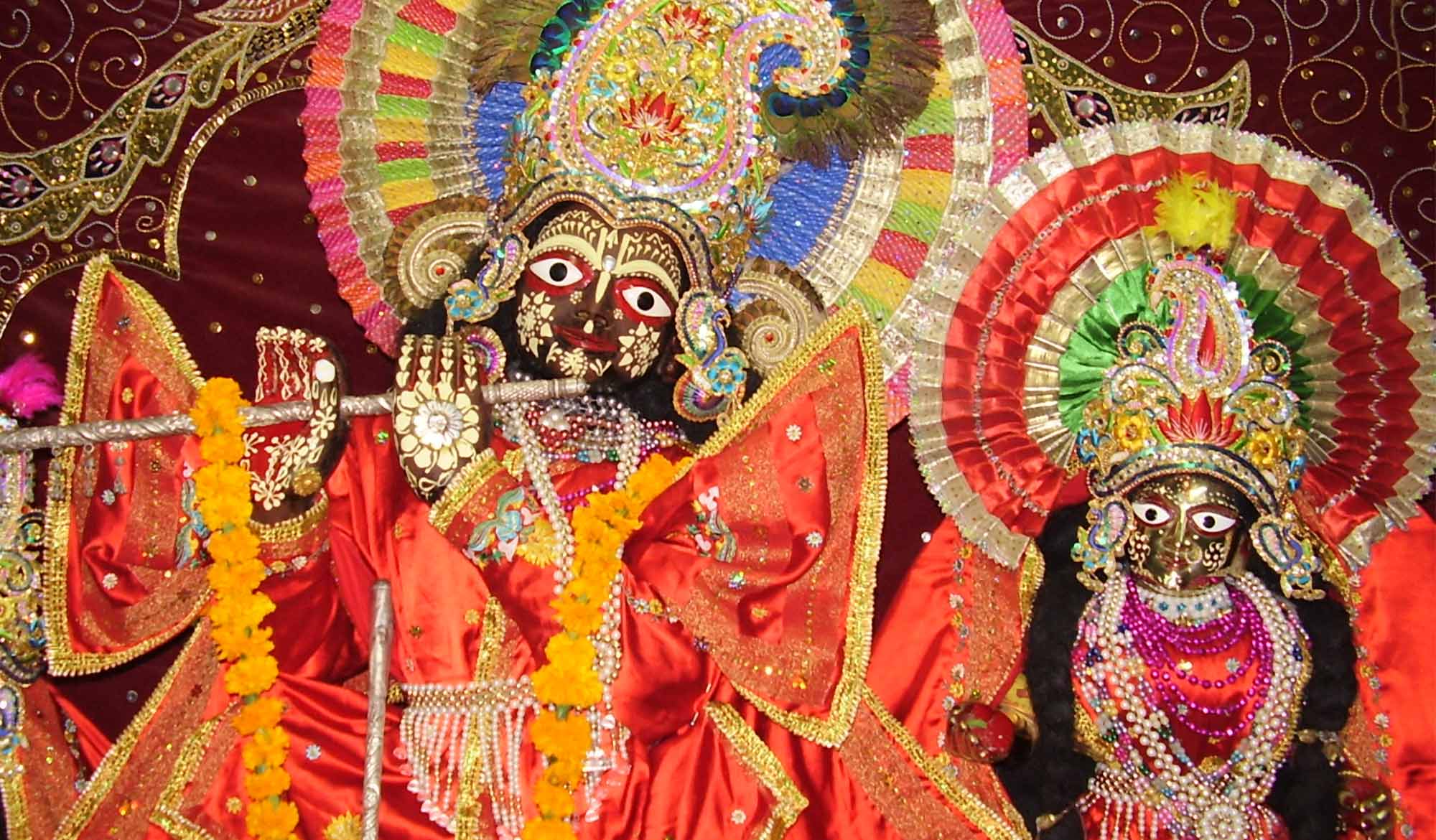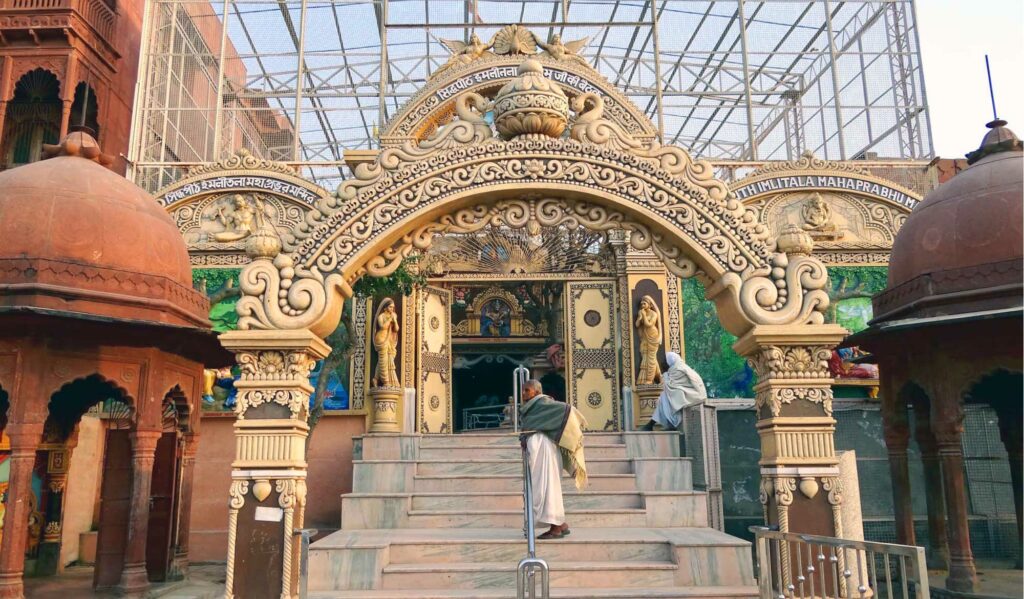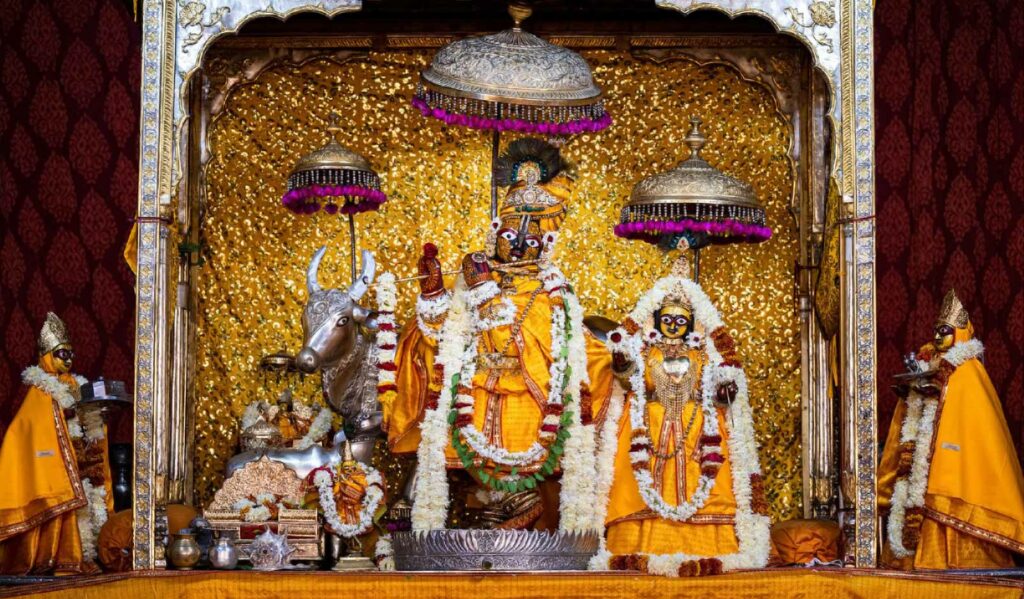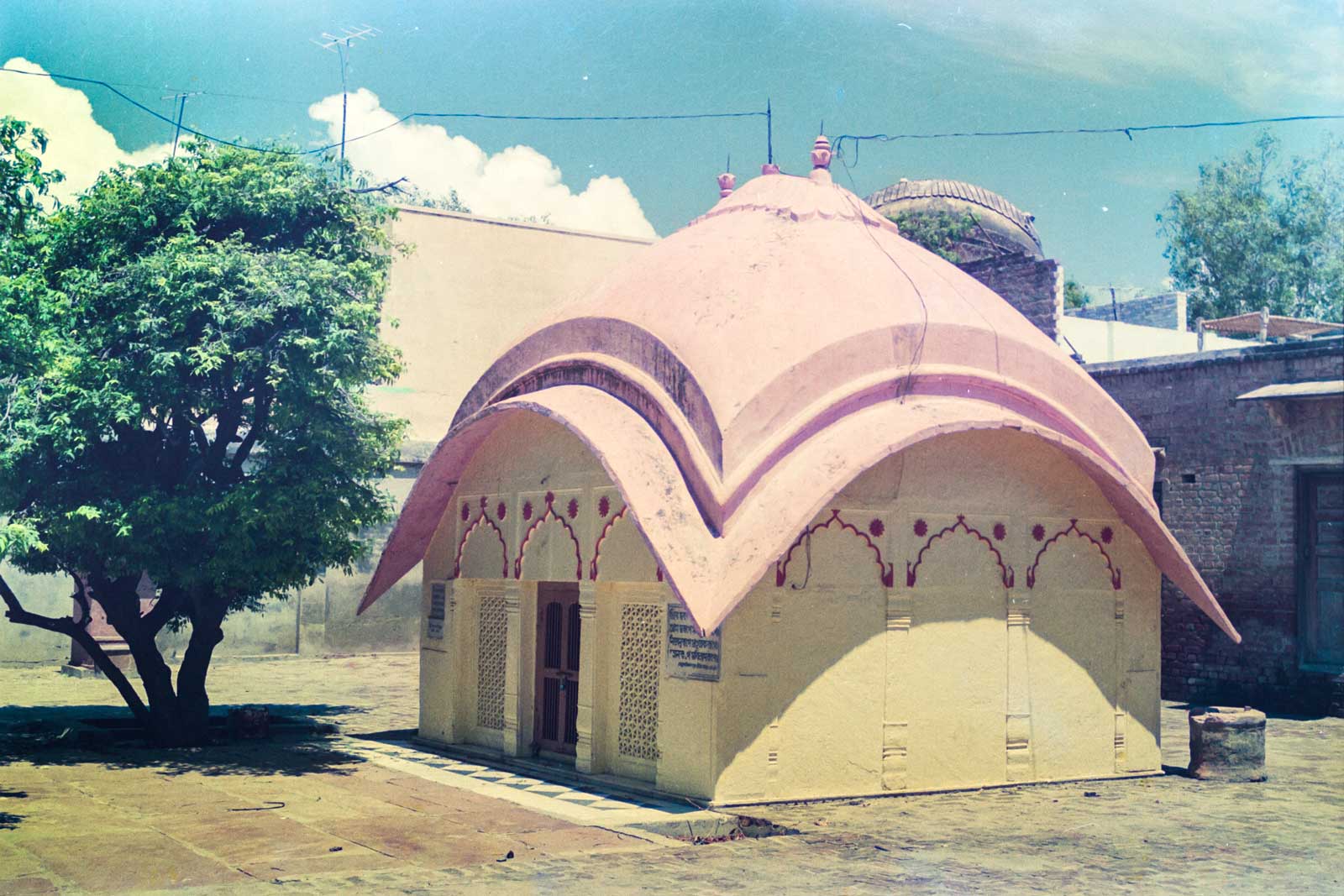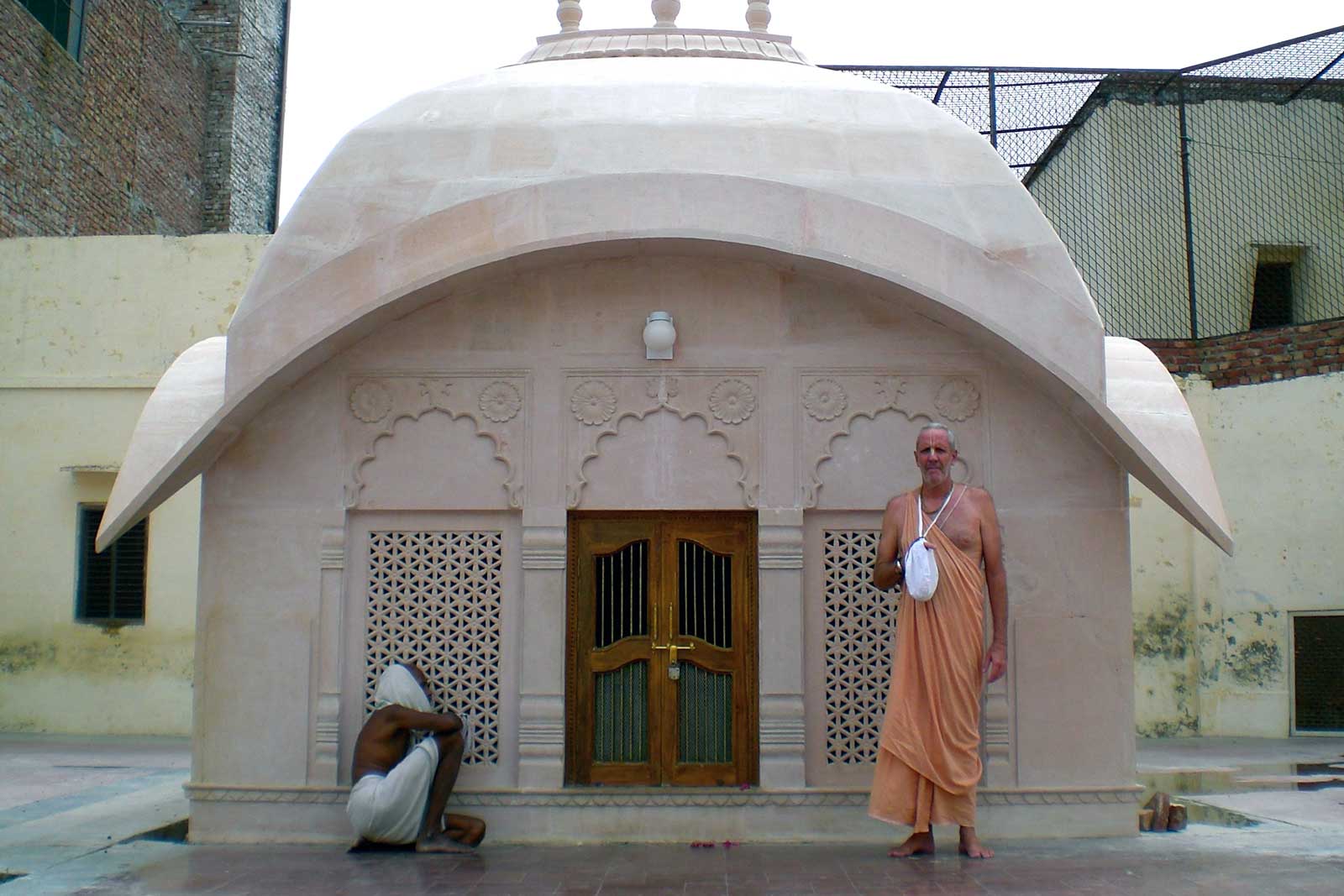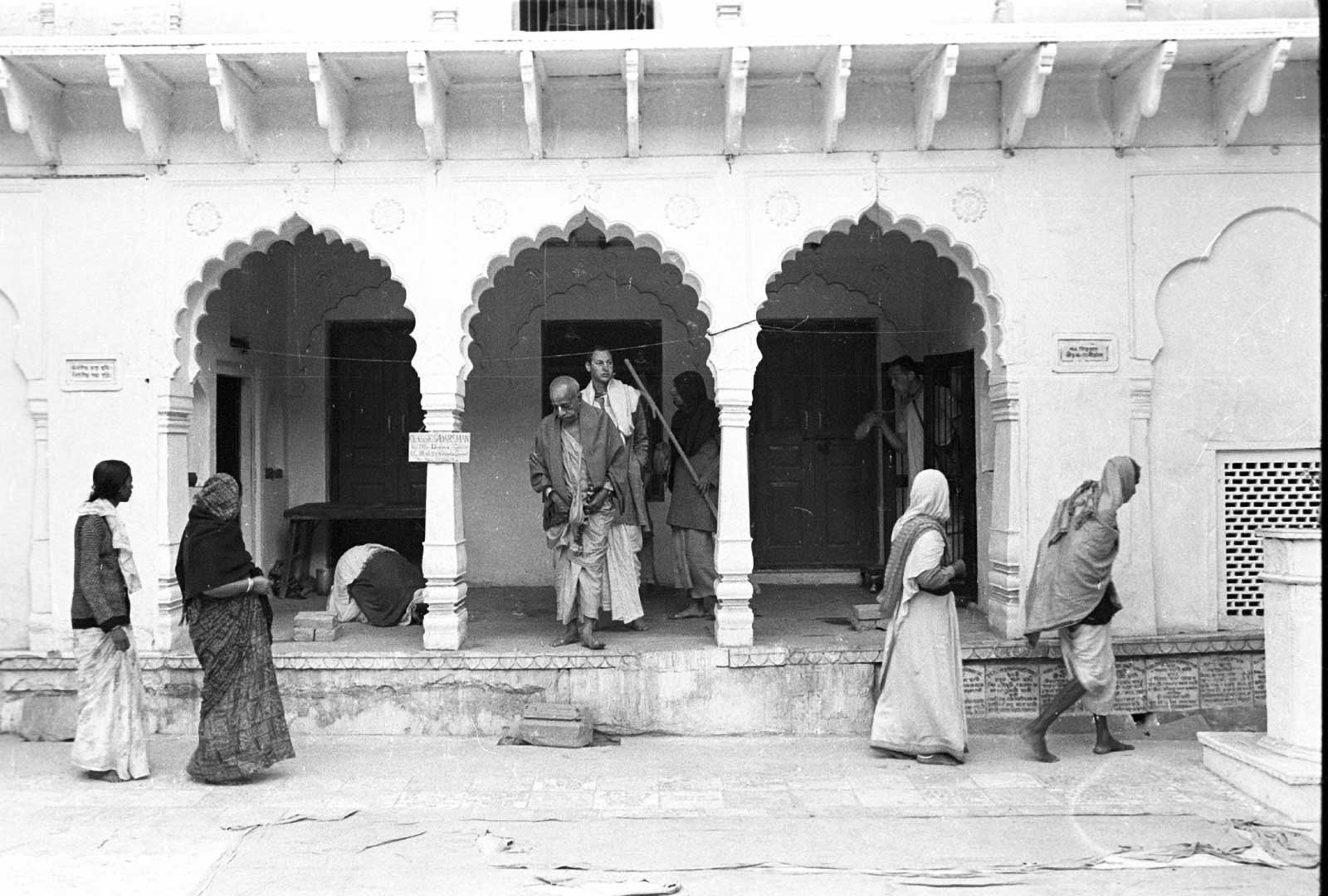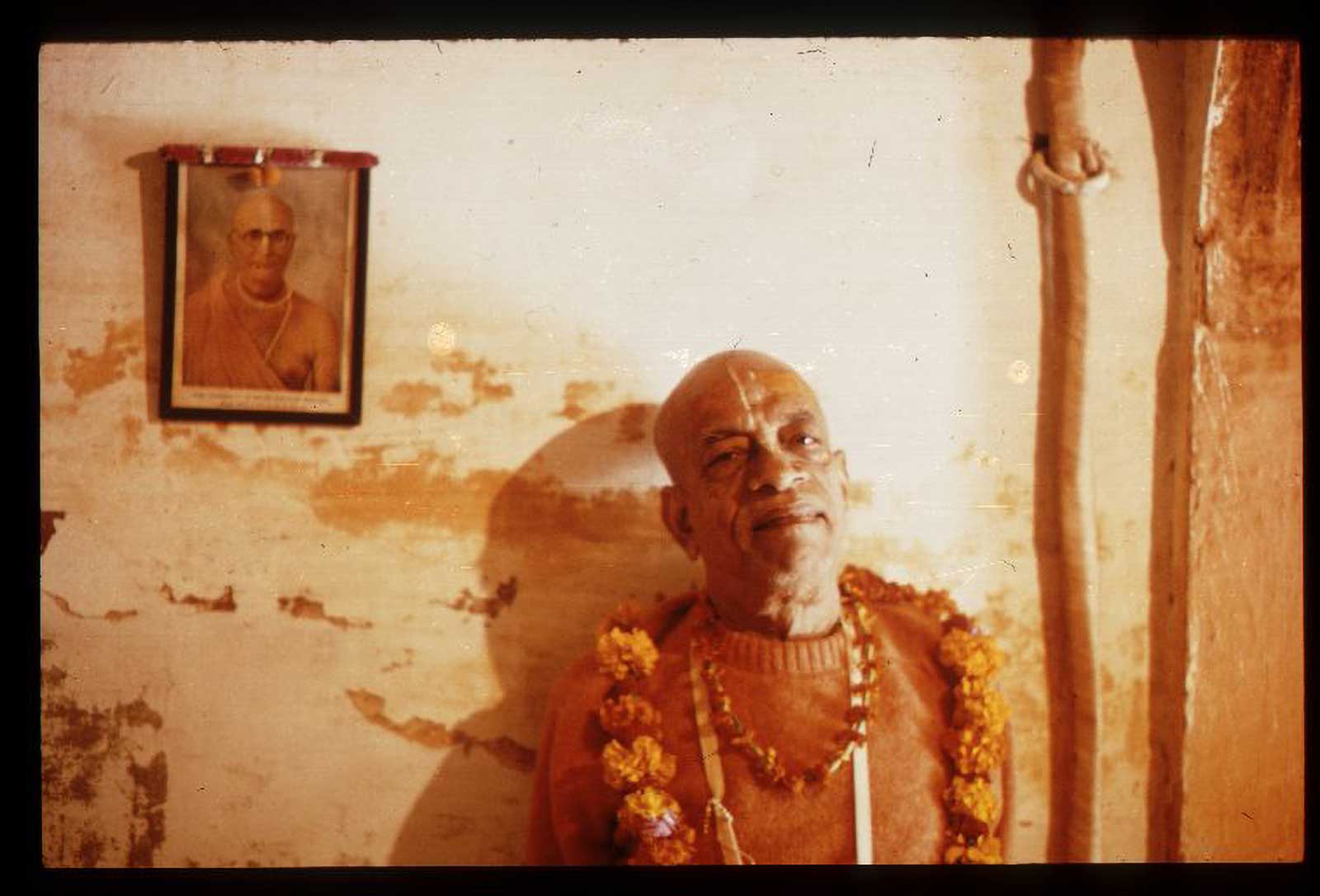Overview
Continuing with our series of articles, this week Śrīla Narasiṅgha Mahārāja speaks about the significance of Rādhā-Dāmodara Temple and Śrīla Prabhupāda’s bhajana-kuṭīra. Mahārāja also relates his own personal experiences in serving Śrīla Prabhupāda at Rādhā-Dāmodara Temple. This article was compiled from various talks Mahārāja gave in the 1990’s and 2000’s.
I have heard that Śrīla Śrīdhara Mahārāja once said that Imlitalā and Rādhā-Dāmodara Temple are the two most important places in Vṛndāvana. Now the question may be raised, “Why Rādhā-Dāmodara Temple?” So many temples are there in Vṛndāvana – Sanātana Gosvāmī’s Madana-mohana Temple, Gopāla Bhaṭṭa Gosvāmī’s Rādhā-Ramaṇa. Actually, there are many levels in the answer to that question of why Rādhā-Dāmodara Temple is so important.
Firstly, one could say that we are Rūpānugas, followers of Śrīla Rūpa Gosvāmī who is the head of our sampradaya, and Rādhā-Dāmodara Temple was his place of bhajana. That’s very true, but according to the thinking of Śrīla Śrīdhara Mahārāja, I would also say that Rādhā-Dāmodara Temple is important because of the position of Śrīla Jīva Gosvāmī, our tattvācārya. He holds such an important position and has established the tattva, the proper conception. All the writings and teachings of Rūpa and Sanātana were supported by Jīva Gosvāmī. He took on all opposition and defended the conceptions of Rūpa-Sanātana which are also the conceptions of Mahāprabhu. In Śrīla Prabhupāda’s Bhāgavatam purports and other writings, he also took on so many opposers – māyāvādīs, śūnyavādīs, materialists, and so many brands of atheism doubting the existence of God. And it was in this place of Jīva Gosvāmī that our Śrīla Prabhupāda took up that work and made Rādhā-Dāmodāra Temple his residence.
(Rūpa Gosvāmī’s Samādhi)
For the disciples and followers of Śrīla Prabhupāda, Rādhā-Dāmodara Temple is also very significant since this is where Prabhupāda’s bhajana-kuṭīra is situated. In fact, Śrīla Prabhupāda once said that, “I live eternally at Rādhā-Dāmodara.”
So we say that on November 14th at 7:20pm, when Śrīla Prabhupāda left this world at Ramana-reti, he came to his bhajana–kuṭīra at Rādhā-Dāmodara Temple, which is his eternal place of residence. Actually, in Gauḍīya Vaiṣṇavism, the bhajana-kuṭīra of the guru is more important than the samādhi. For example, at Rādhā-Dāmodara Temple, the offering to Rūpa Gosvāmī is done at his bhajana-kuṭīra, not his samādhi. That is because in our tradition, the guru lives eternally in his bhajana-kuṭīra, rather than his samādhi. The bhajana-kuṭīra is where he had communion with Kṛṣṇa. We are not form-worshippers. We worship the substance.
Śrīla Prabhupāda’s bhajana-kuṭīra is situated just behind Rūpa Gosvāmī’s samādhi, and he used to look out of his little window while he wrote his purports to the Śrīmad Bhāgavatam and he told us, “By seeing the samādhi of Rūpa Gosvāmī, I got the inspiration to go to the west.” Śrīla Prabhupāda used to say that Rādhā-Dāmodara Temple is the most sacred place in Vṛndāvana. When the ācārya speaks, the deepest thing may not be revealed directly, because the indirect revelation is considered to be higher than the direct revelation. This brings us to a deeper reason as to why Rādhā-Dāmodara Temple is considered to be so important to Gauḍīyas.
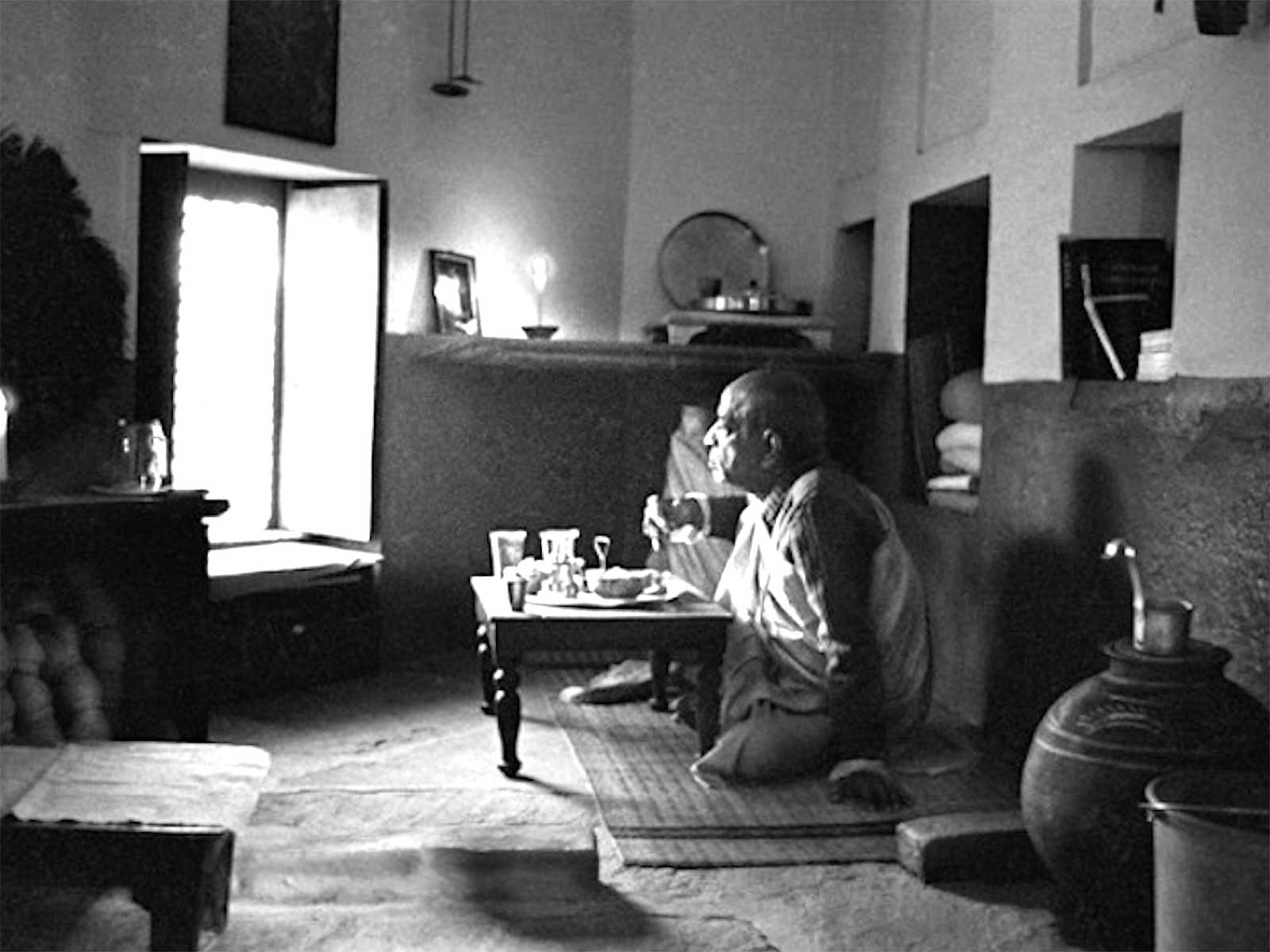
(Śrīla Prabhupāda in his rooms looking out at Rūpa Gosvāmī’s Samādhi)
It is generally known that Mother Yaśodā bound Kṛṣṇa’s waist with ropes and for this reason He is known as Dāmodara. But at Rādhā-Dāmodara Temple, another binding took place. Kṛṣṇa was captured, defeated and tied up – but it wasn’t Mother Yaśodā that tied Him up and He wasn’t tied with ropes. It was the love of Śrīmatī Rādhārāṇī that bound Him. Rādhā-Dāmodara Temple is situated in the area of Sevā-kuñja. It was there that Rādhārāṇī defeated Kṛṣṇa, and that is where Kṛṣṇa worshipped the lotus feet of Rādhārāṇī. That is where He showed that rādhā-dāsyam, service of Rādhārāṇī, is the highest achievement. Thus, this place is called Sevā-kuñja. Sevā means service, signifying the ultimate importance of service to Śrīmatī Rādhārāṇī.
We may talk about high things from time to time – the service of Rādhārāṇī, the position of Rūpa Gosvāmī, Rūpa Mañjarī etc. and such talks may be heard by so many people. But what will they make of it? What will come of it? That is called the subjective plane and there it is a more substantial thing. Many have heard the message. Even the sahajiyās have heard the message about Rādhārāṇī, Kṛṣṇa etc, but they have never actually entered into that plane. They simply make a business out of it. The guru does not always directly reveal the truth, but through his advancement and through revelation in the heart, these things can be realised by the disciple.
So when Śrīla Prabhupāda spoke about Rādhā-Dāmodara Temple, he didn’t mention this intimate pastime of Kṛṣṇa being defeated by Rādhārāṇī, and Kṛṣṇa worshipping Her. He said, “It is the place of Rūpa Gosvāmī and Jīva Gosvāmī” and made his disciples understand, that, “Oh, this is a very sacred place.” He did not go into any depth about that. What are we to understand from that? We should understand that these things are not simply meant for the ear. These are heart realisations, and one should try to become qualified for them. We’ve only heard a little that gives us some idea. For example, people in India may hear something about America, not much, but they hear enough to awaken the desire to want to go to there. It is not possible for them to fully understand what is there in America. No matter how hard we try to explain to them what is in America, they will have to see for themselves. Now if that is true when we just speak of America, then what to speak of the pastimes of Kṛṣṇa? Even Śrīmad Bhāgavatam only points in the direction, “Go this way! Go in the direction of kṛṣṇa-līlā.” In Śrīmad Bhāgavatam a summary of kṛṣṇa-līlā is given. As lengthy as the Tenth Canto is, it is nonetheless, a summary –but it is such an important summary! It is so potent that it will awaken within us a desire to know, “Who is this Kṛṣṇa? Who is this cowherd boy who roams the fields of Vṛndāvana with cows and plays on Govardhana Hill?” By hearing about the pastimes of Kṛṣṇa, this desire may awaken within us. This is our highest fortune in life. It is for this reason that Caitanya Mahāprabhu Himself came. It is for this reason that His devotees came and, it is for this reason also that Śrīla Prabhupāda came to the western world.
At Rādhā-Dāmodara Temple, Śrīla Prabhupāda told one of his disciples, Kṣirodakaśayī Viṣṇu, “If one lives here at the Rādhā-Dāmodara Temple, one lives with the previous ācāryas. So not only does Śrīla Prabhupāda live eternally at Rādhā-Dāmodara, but Jīva, Rūpa and all the others have a presence there. Every significant Vaiṣṇava in our sampradaya used to come and stay there – Viśvanātha Cakravartī Ṭhākura, Lokanātha Gosvāmī, Narottama Dāsa Ṭhākura. It didn’t matter if they had their own temples – everybody came to Rādhā-Dāmodara. It was the main hub of the Gosvāmīs.
(Śrīla Prabhupāda at Rādhā-Dāmodara Temple)
I have been coming to Rādhā-Dāmodara Temple regularly since Śrīla Prabhupāda’s time. The first time I came was in 1976 with my godbrother Ṛkṣarāja. He had been there before and we just stopped in for darśana. It was very different then – there were nice trees around it and all the surrounding buildings either didn’t exist or they were only one storey high. But there are no trees there anymore. It has all changed. Before, when you came through the parikramā trail at the back where the temple gośālā is now, there used to be a kuñja full of trees which formed a canopy. It was completely covered over like a tunnel, and it was always very cool there. The story is that in the heat of the day, the Gosvāmīs would sit and take prasādam there or they would talk together.
Anyhow, in April of 1976, three of us, myself, Ṛkṣarāja and Garga Muni, were called to see Śrīla Prabhupāda in his rooms one afternoon at Kṛṣṇa-Balarāma Temple. Garga Muni had been asked to take care of Prabhupāda’s bhajana-kuṭīra at Rādhā-Dāmodara Temple, but he was making his own plans, so he asked Ṛkṣarāja and myself to come along with him for the meeting. Prabhupāda told us, “Generally, worship in the spiritual master’s bhajan-kuṭīra doesn’t start until after his departure, but I want to initiate the system of worship now, so that I know it is going on.” He instructed us to keep a photograph of him in his room and the devotees there would cook and also offer some of the prasādam of Rādhā-Dāmodara to him. He wanted a written inventory of all the paraphernalia in his room including books, manuscripts, pots, plates, spoons, cups etc. He also requested that only his sannyāsī disciples should maintain the rooms and do service there. They would stay in the rooms for one to three months and then rotate. Just like during his presence – he was always calling his top preachers to come and serve him and them sending them out.
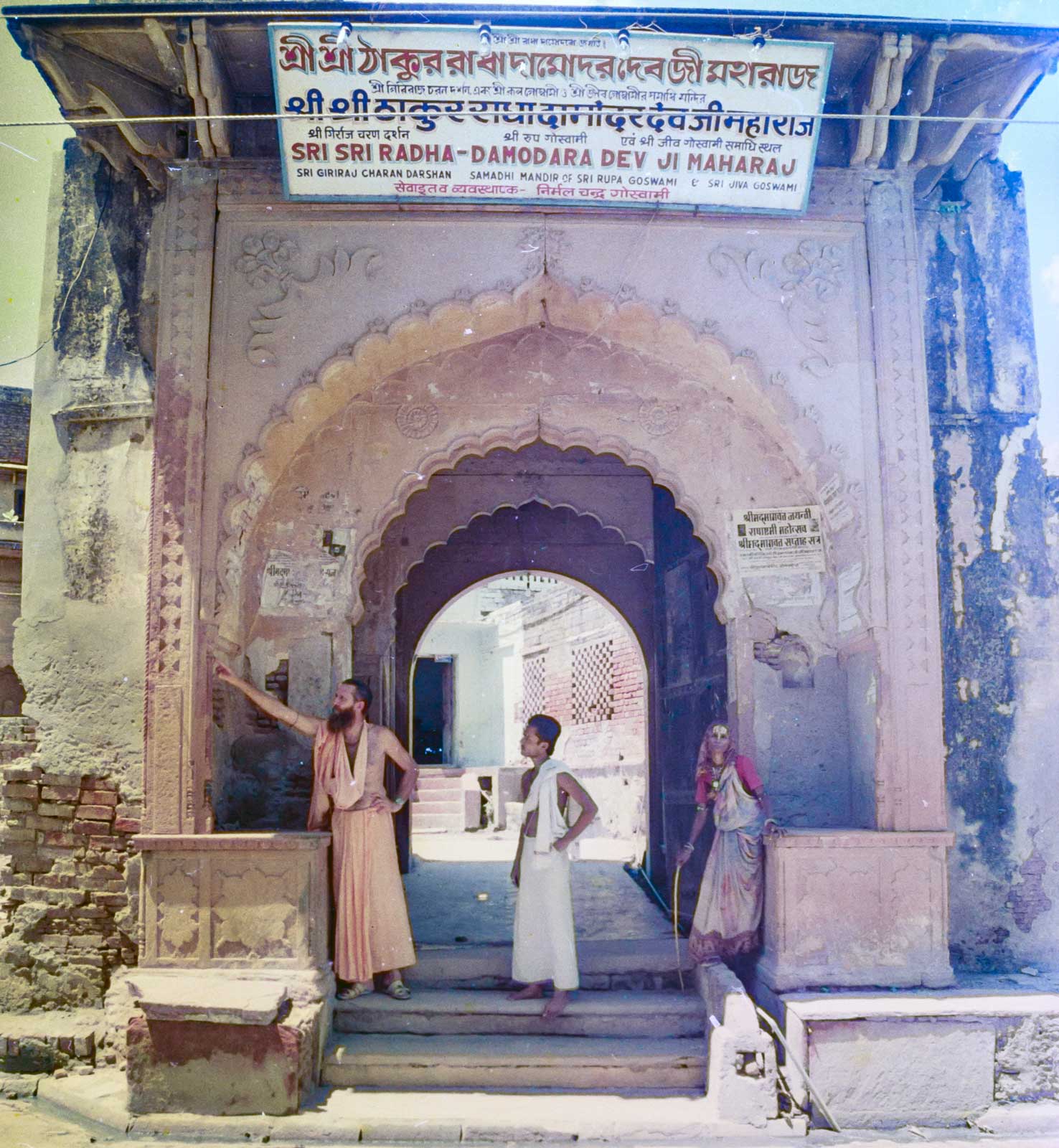
(Narasiṅgha Mahārāja in front of Rādhā-Dāmodara Temple in 1988)
So Ṛkṣarāja and myself went that same day to Rādhā-Dāmodara Temple to begin the service. Prabhupāda’s rooms had been locked up for a long time, so we unlocked them and immediately started sweeping. They were in a state of deterioration, so we started gathering up everything that was in the rooms and took it all back to Kṛṣṇa-Balarāma Temple, where some devotees took charge in preserving all that paraphernalia. Under the bed, there was an old metal trunk full of papers and documents, and when I picked it up the bottom fell through – it was so old that the underside had completely rusted. Most of the papers in the trunk were receipts and accounts of how much Prabhupāda had spent on vegetables, paper, pens etc. The one thing in there which was of the most importance was the manuscript of what we later printed in book-form as In Search of the Ultimate Goal of Life.
The floor in Śrīla Prabhupāda’s room was all cracked, so we put a new floor in. The stone slabs that are now in Prabhupāda’s room, where his deity is, were laid by Ṛkṣarāja and myself. I purchased a new bed and put that in there (which is still there at present), and the seat that the deity of Prabhupāda is sitting on was brought from his rooms at Kṛṣṇa-Balarāma Temple.
Anyhow, after we had finished renovating Prabhupāda’s rooms, we began the sevā there. We set up a system of cooking, offerings, guru-pūjā, ārati etc, and just as we started, we were suddenly ousted by Prabhupāda’s personal secretary. Śrīla Prabhupāda had made it very clear in his meeting with us that he only wanted sannyāsīs to take care of his bhajana–kuṭīra, but this gentleman decided to replace us with a householder and his wife.
All this transpired during the summer, and as anyone who has been in Vṛndāvana knows, summers in Vraja are extreme. So a week later, Śrīla Prabhupāda suddenly called for those householders one afternoon and asked them if they had gone that day to Rādhā-Dāmodara Temple to do the offering and ārati in his bhajana-kuṭīra. The man told Prabhupāda, “Oh, we didn’t go there today. It’s far too hot for my wife to cook.” I was told later that when Prabhupāda heard this, his lip curled with disgust and he called him ‘a dancing dog in the hands of a woman.’
Anyhow, after Śrīla Prabhupāda’s time, different devotees were doing the sevā in Prabhupāda’s bhajana-kuṭīra, but it wasn’t according to Prabhupāda’s instructions. Some devotees were actually living in his rooms, which was not what he wanted. He wanted devotees to come from the Kṛṣṇa-Balarāma Temple, do the sevā and then go back. But when devotees actually began living in Prabhupada’s rooms, they would hang their laundry everywhere, leave piles of books, papers and clothes on the floor and it was a total mess. The rooms began falling apart again, and the relationship between Iskcon and the Rādhā-Dāmodara gosvāmīs also fell apart. That finally culminated in a messy court-case which was totally unnecessary.
Anyhow, in 1988, I came to live in Vṛndāvana and rented a room at the Amiyā Nimāi Temple in Gopīnātha Bazaar for a year. During that time, I would come to Rādhā-Dāmodara Temple regularly and I got to know Nirmal Chandra Goswami and his five sons. He would always invite me for festivals and we got on very well. And over the years, our relationship got closer till we were finally given some residence and service at Rādhā-Dāmodara by the mercy of Śrīla Prabhupāda.
There is one letter where Śrīla Prabhupāda writes that the worship of Rādhā-Kṛṣṇa is very high. It is meant for those who are on the platform of rāga-mārga. He says that, “In all our temples, we are actually worshipping Lakṣmī-Nārāyaṇa. We do not worship Rādhā-Kṛṣṇa in their original forms.” That is because Kṛṣṇa never leaves Vṛndāvana. All forms of Kṛṣṇa outside Vṛndāvana are His expansions. When we are following vaidhi–bhakti, rules and regulations must be there. So at the beginning there must be grandeur and aiśvarya-bhāva so we can appreciate, “Oh, Kṛṣṇa is God!” otherwise we can become sahajiyā. So where does our worship go? Lakṣmī-Nārāyaṇa are automatically present in Rādhā-Kṛṣṇa also. We are focusing on Rādhā-Kṛṣṇa. When we do ārati to Rādhā-Mādhava, we are not meditating on Lakṣmī-Nārāyaṇa. So ultimately our worship goes to Vṛndāvana. That is where Kṛṣṇa is served directly. We are serving Gaura-Rādhā-Mādhava in South India, the place of jñāna and aiśvarya. So, we have to be a little careful with that. Too much vaidhi and strictness and we will become dry. We will be ‘hurled down to Vaikuṇṭha’ as Śrīla Śrīdhara Mahārāja says. That is why it is very important to have a place in Vṛndāvana, and in that regard we are so fortunate. It is beyond our wildest expectations, dreams, or wishes that we have both service and a place to worship at Rādhā-Dāmodara Temple.
Related Articles and Books
- 📚Pilgrimage With Swami Narasiṅgha Series Index
- 📖 In Search of the Ultimate Goal of Life by Śrīla A.C. Bhaktivedānta Swami Prabhupāda
- 📖 Śrī Dāmodara Kathā by Śrīla Bhakti Gaurava Narasiṅgha Mahārāja
- 📖 Prabhupāda Vijaya by Śrīla Bhakti Gaurava Narasiṅgha Mahārāja
- The Ontological Position of Śrī Śrī Rādhā-Govinda by Śrīla B.R. Śrīdhara Deva Gosvāmī
- Śrī Govardhana Pūjā by Śrīla Bhakti Rakṣaka Śrīdhara Deva Gosvāmī
- The Vṛndāvana Express and the Navadvīpa Special by Śrīla Bhakti Rakṣaka Śrīdhara Deva Gosvāmī
- Vraja Bhāva by Śrīla Bhakti Gaurava Narasiṅgha Mahārāja
- The Worship of Govardhana by Śrīla Bhakti Gaurava Narasiṅgha Mahārāja
- Dāsa Gosvāmī and the Unique Position of Govardhana by Śrīla Bhakti Gaurava Narasiṅgha Mahārāja
- Ācāryas at Śrī Śrī Rādhā-Dāmodara Temple, Vṛndāvana by Śrīla Bhakti Gaurava Narasiṅgha Mahārāja
- Pilgrimage to Vṛndāvana-dhāma by Śrīla Bhakti Gaurava Narasiṅgha Mahārāja
- The Appearance of Rādhā-kuṇḍa by Śrīla Bhakti Gaurava Narasiṅgha Mahārāja
- Prema Dhāma Deva Stotram with the Narasiṅgha Sevaka Commentary – Verses 41-45 (regarding Imlitalā) by Swami B.V. Giri
Further Reading
Pilgrimage with Swami Narasiṅgha – Part 7: Keśī Ghāṭa
Continuing with our pilgrimage series, this week Śrīla Narasiṅgha Mahārāja takes us to Keśī Ghāṭā where he tells us about Madhumaṅgala’s meeting with the Keśī demon, what Keśī represents, and how Śrīla Prabhupāda almost acquired Keśī Ghāṭa. Mahārāja also narrates his own experience. This article has been adapted from a number of talks and articles by Narasiṅgha Mahārāja.
Prema Dhāma Deva Stotram with the Narasiṅgha Sevaka Commentary – Verses 61-65
In verses 61 to 65 of 'Prema Dhāma Deva Stotram', Śrīla Śrīdhara Mahārāja narrates the pastime of Śrī Caitanya at Caṭaka Parvata In Purī and explains how the scriptures produced by Brahmā and Śiva are ultimately searching for the personality of Mahāprabhu who is merciful too all jīvas, no matter what their social position.
Prabhupāda Śrīla Sarasvatī Ṭhākura’s Visit to Ayodhyā
With the forthcoming observance of Śrī Rāma Navamī, we present 'Prabhupāda Śrīla Sarasvatī Ṭhākura’s Visit to Ayodhyā' written by Śrīla Bhaktisiddhānta Sarasvatī Ṭhākura Prabhupāda from The Gaudīyā magazine, Vol 3. Issue 21/ In December 1924, after visiting Benares and Prāyāga, Sarasvatī Ṭhākura visited the birth-site of Śrī Rāmācandra in Ayodhyā.
Śaraṇāgati – The Only Path to Auspiciousness
In this article, 'Śaraṇāgati - The Only Path to Auspiciousness', Dhīra Lalitā Dāsī analyses the process of śaraṇāgati (surrender) beginning with śraddhā (faith). She also discusses the role of śāstra and the Vaiṣṇava in connection with surrender.
Pilgrimage with Swami Narasiṅgha – Part 7: Keśī Ghāṭa
Continuing with our pilgrimage series, this week Śrīla Narasiṅgha Mahārāja takes us to Keśī Ghāṭā where he tells us about Madhumaṅgala’s meeting with the Keśī demon, what Keśī represents, and how Śrīla Prabhupāda almost acquired Keśī Ghāṭa. Mahārāja also narrates his own experience. This article has been adapted from a number of talks and articles by Narasiṅgha Mahārāja.
Prema Dhāma Deva Stotram with the Narasiṅgha Sevaka Commentary – Verses 61-65
In verses 61 to 65 of 'Prema Dhāma Deva Stotram', Śrīla Śrīdhara Mahārāja narrates the pastime of Śrī Caitanya at Caṭaka Parvata In Purī and explains how the scriptures produced by Brahmā and Śiva are ultimately searching for the personality of Mahāprabhu who is merciful too all jīvas, no matter what their social position.
Prabhupāda Śrīla Sarasvatī Ṭhākura’s Visit to Ayodhyā
With the forthcoming observance of Śrī Rāma Navamī, we present 'Prabhupāda Śrīla Sarasvatī Ṭhākura’s Visit to Ayodhyā' written by Śrīla Bhaktisiddhānta Sarasvatī Ṭhākura Prabhupāda from The Gaudīyā magazine, Vol 3. Issue 21/ In December 1924, after visiting Benares and Prāyāga, Sarasvatī Ṭhākura visited the birth-site of Śrī Rāmācandra in Ayodhyā.
Śaraṇāgati – The Only Path to Auspiciousness
In this article, 'Śaraṇāgati - The Only Path to Auspiciousness', Dhīra Lalitā Dāsī analyses the process of śaraṇāgati (surrender) beginning with śraddhā (faith). She also discusses the role of śāstra and the Vaiṣṇava in connection with surrender.


